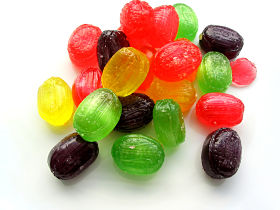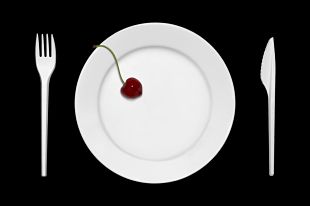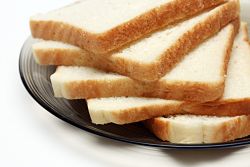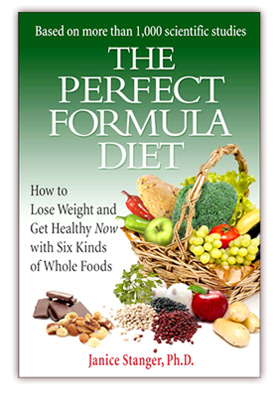Why Serving Sizes Undercut Health and Weight Loss
Run-of-the-mill diets focus on controlling the amount you eat by limiting portions. This is an attempt to fit a manmade, arbitrary concept (“serving size”) into a natural biological system (your body). While this strategy may work for some people for a short time, the long-term outcome is often counter to health and weight goals.
The USDA’s Dietary Guidelines for Americans 2010 is typical. Some of the serving sizes this report lists include:
• Bread: one slice
• Cooked rice: half a cup
• Cut up vegetables: half a cup
• Fruit: one medium piece
• Cooked beans: half a cup
• Milk: one cup
• Cooked meat, poultry, or fish: one ounce
• Soft margarine: one teaspoon
• Sugar: one tablespoon
Here are six reasons that portion control ultimately will not succeed in getting you to a trim weight and perfect health.

Calories from a serving of fruit-flavored candy are in no way equivalent to caloris from a serving of fruit
ONE. It’s too complicated. The USDA Guidelines, for example, first have you determine your daily caloric needs. Then there is a complex system to determine how much you need of various foods, either by the day or week. These Guidelines assume you measure, weigh, and track all your food and beverages. How realistic is this? How many people have the time to precisely measure and record every sip or bite they consume?
TWO. Your metabolism slows when you do follow portion control guidelines that artificially limit calories. You are not eating enough. Your body believes you are starving and slows down to conserve energy. Your digestive tract becomes ultra-skilled at absorbing all the calories you do consume. When you finally start eating more, your weight bounces back very quickly.
THREE. Portion control strategies may indiscriminately includes all foods – even empty calorie junk foods – as long as they fit the serving size guidelines. A
calorie from candy or white bread is regarded the same as a calorie from black beans or apples.
Your body is finely tuned for survival. You have intricate sensors that activate your hunger when you need nutrients or energy. Vegetables, fruits, potatoes, beans, and whole grains are dense with nutrients that satisfy your body’s nutrient sensors.
Manufactured foods and animal foods can’t compete. Nutrient-poor junk food, in any serving size, will not turn off your hunger. Moreover, even small amounts of animal and highly processed foods can spark the inflammation that leads to so many chronic diseases. Examples include cardiovascular disease, arthritis, sinusitis, type 2 diabetes, autoimmune disorders, and even cancer.
FOUR. Your stomach holds about a liter of food at any one time. This is about 34 ounces – a bit over a quart. When your stomach is full, stretch receptors kill hunger until the stomach empties. Tiny portions do not satisfy your stomach’s stretch receptors, even if you are consuming nutrient dense whole foods.
The problem is compounded if some of your tiny servings are nutrient-poor manufactured or animal foods. You will feel hungry, then eventually famished. Food cravings will take over your brain. You will eventually give in to your body’s hunger, its demand for survival necessities. Holding out against hunger is like holding your breath. You can do it for only so long.
FIVE. You feel weak and don’t want to exercise when you are eating less than your body needs. The lack of exercise cuts your calorie expenditure, making it harder to lose weight and stay active. Your muscles can shrivel, which lowers your resting metabolism and further reduces the amount of calories you burn each day.
SIX. Your self-confidence is undercut every time you eat more than the designated portions of each food. The scale does not budge. Or even worse, you are thrilled to lose weight but disappointed to gain it back. You feel like a failure and conclude you just can’t stay trim. Soon you are chowing down on cookies and candy bars to ease the pain. The portion size game is over. Expensive drugs with dangerous side effects substitute for healthy foods. The drugs disguise the risk factors for poor health and symptoms of disease. Chronic inflammation continues though, unchecked, as you struggle with pain and deteriorating health.

On a whole foods, plant-based diet you can enjoy a plateful of satisfying foods and still permanently lose weight. Not to mention regain your health.
A rejection of artificial serving sizes does not mean you should eat unlimited amounts. Instead, you should rely on your built-in, natural portion controller – also called hunger.
On a whole foods, plant-based diet, you can eat until you are satisfied and still lose weight. The trick is to eat generously of all the kinds of whole foods – vegetables, fruits, potatoes, beans, and whole grains. Eat flavorful foods with mouthwatering amounts of herbs and spices. These tasty, fragrant additions are dense with beneficial phytochemicals (powerful nutrients found only in plants) and will help keep your appetite in check. Add an occasional handful of nuts or seeds a few times a week and two tablespoons a day of ground flax seeds.
This eating plan – the Perfect Formula Diet – allows you to eat when you are hungry and stop when you are satisfied. When you are moderately hungry, it’s time to eat again.
You don’t need to worry if you get hungry between meals, because mealtimes are as artificial as portion sizes are. Instead, focus on your body’s own reliable hunger signals, which have evolved over hundreds of millions of years of life on earth. Enjoy not-meals. Break out of the serving size prison. You’ve been liberated by a strategy that works.
If you liked this post, you may want to find out why Weight Watchers sets you up for disappointment if you just look at the hype about a recent study.
Intrigued? Now you can use our Whole Foods Blog Finder to target informative, fun postings on plant-based nutrition. Quick information at no cost!
Blog posting by Janice Stanger, Ph.D. Janice authored The Perfect Formula Diet: How to Lose Weight and Get Healthy Now With Six Kinds of Whole Foods. This easy-to-follow eating plan is built on sustainable food choices that can prevent, or even reverse, most chronic disease.
Tags: 2010 USDA Guidelines for Americans, getting healthy, Janice Stanger, lose weight, nutrition facts, Perfect Formula Diet, phytochemicals, Plant-based nutrition, portion control, serving size, vegetables, weight loss, whole foods, whole foods plant-based diet






